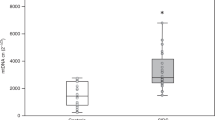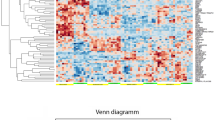Abstract
Although evidence shows that victims of sudden infant death syndrome (SIDS) suffer repetitive episodes of hypoxemia, only subtle abnormalities have been found in their brains by light microscopy. The aim of the present study was to determine whether apoptosis, a form of cell death that can be triggered by hypoxemia and that leaves no scarring detectable by light microscopy, would be present in hypoxia-sensitive brain regions of SIDS victims. We looked for the presence of apoptosis with an in situ end-labeling method that detects DNA fragmentation. We studied 29 SIDS victims who were age-matched to nine control cases. We found significant neuronal apoptosis in 79% of the SIDS cases: 55% of the cases positive in the hippocampus and 96% positive in the brainstem. Whereas the distribution of apoptosis in the hippocampus was in hypoxia-sensitive subregions, the distribution in the brainstem was mostly in dorsal nuclei, including those involved with sensation in the face and position of the head (nucleus of the spinal trigeminal tract and vestibular nuclei). The control cases showed no significant apoptosis in the hippocampus and a mild degree in the brainstem in three cases. Our results indicate the occurrence of an acute insult at least several hours before death, an insult from which the infants had apparently recuperated. This suggests that SIDS victims suffered repeated apoptosis resulting in significant neuronal damage and, thus, functional loss in key brain regions. The involvement of specific nuclei in the brainstem may be linked to the fact that prone sleeping is a significant risk factor for SIDS. Enhanced neuronal death by apoptosis may thus have major implications for understanding the sequence of events leading to SIDS.
Similar content being viewed by others
Log in or create a free account to read this content
Gain free access to this article, as well as selected content from this journal and more on nature.com
or
Abbreviations
- SIDS:
-
sudden infant death syndrome
- HPS:
-
hematoxylin-phloxine-saffron
References
Willinger M, James LS, Catz C 1991 Defining the sudden infant death syndrome (SIDS): deliberations of an expert panel convened by the National Institute of Child Health and Human Development. Pediatr Pathol 11: 677–681
Hunt CE 1992 The cardiorespiratory control hypothesis for sudden infant death syndrome. In: Hunt CE (ed) Apnea and SIDS. Clinics in Perinatology series. WB Saunders, Philadelphia, 757–771.
Gillan JE, Curran C, O'Reilly E, Seamus FC, Unwin AR 1989 Abnormal patterns of pulmonary neuroendocrine cells in victims of sudden infant death syndrome. Pediatrics 84: 828–834
Naeye RL 1974 Hypoxia and the sudden infant death syndrome. Science 186: 837–838
Rognum TO, Saugstad OD, Θyasæter S, Olaisen B 1988 Elevated levels of hypoxanthine in vitreous humor indicate prolonged cerebral hypoxia in victims of sudden infant death syndrome. Pediatrics 82: 615–618
Valdes-Dapena M, Gillane MM, Catherman R 1976 Brown fat retention in sudden infant death syndrome. Arch Pathol Lab Med 100: 547–549
Williams A, Vawter G, Reid L 1979 Increased muscularity of the pulmonary circulation in victims of sudden infant death syndrome. Pediatrics 63: 18–24
Del Bigio MR, Becker LE 1994 Microglial aggregation in the dentate gyrus: a marker of mild hypoxic-ischemic brain insult in human infants. Neuropathol Appl Neurobiol 20: 144–151
Kinney HC, Filiano JJ, Harper RM 1992 The neuropathology of the sudden infant death syndrome. J Neuropathol Exp Neurol 51: 115–126
Ferrer I, Tortosa A, Macaya A, Sierra A, Moreno D, Munell F, Blanco R, Squier W 1994 Evidence of nuclear DNA fragmentation following hypoxia-ischemia in the infant rat brain, and transient forebrain ischemia in the adult gerbil. Brain Pathol 4: 115–122
Mehmet H, Yue X, Squier MV, Lorek A, Cady E, Penrice J, Sarraf C, Wylezinska M, Kirkbride V, Cooper C 1994 Increased apoptosis in the cingulate sulcus of newborn piglets following transient hypoxia-ischemia is related to the degree of high energy phosphate depletion during the insult. Neurosci Lett 181: 121–125
Rosenbaum DM, Michaelson M, Batter DK, Doshi P, Kessler JA 1994 Evidence for hypoxia-induced, programmed cell death of cultured neurons. Ann Neurol 36: 864–870
Clarke PGH 1990 Developmental cell death: morphological diversity and multiple mechanism. Anat Embryol 181: 195–213
Wyllie AH 1980 Glucocorticoid-induced thymocyte apoptosis is associated with endogenous endonuclease activation. Nature 284: 555–556
Wyllie AH, Morris GG, Smith AL, Dunlop D 1984 Chromatin cleavage in apoptosis: association with condensed chromatin morphology and dependence on macromolecular synthesis. J Pathol 142: 67–77
Gavrieli Y, Sherman Y, Ben-Sasson SA 1992 Identification of programmed cell death in situ via specific labeling of nuclear DNA fragmentation. J Cell Biol 119: 493–501
Wijsman JH, Jonker YY, Keijzer R, Van de Velde CJH, Cornelisse CJ, Van Dierendonck JH 1993 A new method to detect apoptosis in paraffin sections: in situ end-labeling of fragmented DNA. J Histochem Cytochem 41: 7–12
Waters KA, Côté A 1996 Evidence for previous hypoxia in a population of infants dying from SIDS. Pediatr Res 39: 392A ( abstr)
Kirino T 1982 Delayed neuronal death in the gerbil hippocampus following ischemia. Brain Res 239: 57–69
Schmidt-Kastner R, Freund FF 1991 Selective vulnerability of the hippocampus in brain ischemia. Neuroscience 40: 599–616
Pulsinelli WA 1985 Selective neuronal vulnerability: morphological and molecular characteristics. Progr Brain Res 63: 29–37
Friede RL 1972 Ponto-subicular lesions in perinatal anoxia. Arch Pathol 94: 343–354
Mito T, Kamei A, Takashima S, Becker LE 1993 Clinicopathological study of pontosubicular necrosis. Neuropediatrics 24: 204–207
Yue X, Mehmet H, Penrice J, Cooper C, Cady E, Wyatt JS, Reynolds EO, Edwards AD, Squier MV 1997 Apoptosis and necrosis in the newborn piglet brain following transient cerebral hypoxia-ischemia. Neuropathol Appl Neurobiol 23: 16–25
Morioka T, Kalehua AN, Streit WJ 1991 The microglial reaction of the rat dorsal hippocampus following transient forebrain ischemia. J Cereb Blood Flow Metab 11: 966–973
Jorgensen MB, Finsen BR, Castellano B, Biemer NH, Zimmer J 1993 Microglial and astroglial reactions to ischemic and kainic acid-induced lesions of the adult rat hippocampus. Exp Neurol 120: 70–88
Gerhnann J, Bonnekoh P, Miyazawa T, Hossmann KA, Kreutzberg GW 1992 Immunocytochemical study of an early microglial activation in ischemia. J Cereb Blood Flow Metab 12: 257–269
Bursch W, Kleine L, Tenniswood M 1990 Biochemistry of cell death by apoptosis. Biochem Cell Biol 68: 1071–1074
Brown AW, Brierly JB 1968 The nature, distribution, and earliest stages of anoxic-ischaemic nerve cell damage in the rat brain as defined by the optical microscope. Br J Exp Pathol 49: 87–106
Auer RN, Benveniste H 1997 Hypoxia and related conditions. In: Graham DI, Lantos PL (eds) Greenfield's Neuropathology. Arnold, London, 263–314.
Eke A, Conger KA, Anderson M, Garcia JH 1990 Histologic assessment of neurons in rat models of cerebral ischemia. Stroke 21: 299–304
Kirino T, Sano K 1984 Fine structural nature of delayed neuronal death following ischemia in the gerbil hippocampus. Acta Neuropath 62: 209–216
Pulsinelli WA, Brierly JB, Plum F 1982 Temporal profile of neuronal damage in a model of transient forebrain ischemia. Ann Neurol 11: 491–498
Li Y, Chopp M, Jiang N, Yao F, Zaloga C 1995 Temporal profile of in situ DNA fragmentation after transient middle cerebral artery occlusion in the rat. J Cereb Blood Flow Metab 15: 389–397
Meyn RE 1994 Programmed cell death in normal development and disease. Cancer Bull 46: 120–124
Rice JE, Vannucci RC, Brierley JB 1981 The influence of immaturity on hypoxic-ischemic brain damage in the rat. Ann Neurol 9: 131–141
Poets CF, Samuels MP, Noyes JP, Hewertson J, Hartman H, Holder A, Southall DP 1993 Home event recordings of oxygenation, breathing movements, and heart rate and rhythm in infants with recurrent life-threatening events. J Pediatr 123: 693–701
Kinney HC, Burger PC, Harrell FE, Hudson RP 1983 'Reactive gliosis' in the medulla oblongata of victims of the sudden infant death syndrome. Pediatrics 72: 181–187
Summers GC, Parker VC 1981 The brainstem in the sudden infant death syndrome: a postmortem survey. Am J Forensic Med Pathol 2: 23–30
Takashima S, Armstrong D, Becker LE, Bryan C 1978 Cerebral hypoperfusion in the sudden infant death syndrome? Brainstem gliosis and vasculature. Ann Neurol 4: 257–262
Ferrer I, Tortosa A, Macaya A, Sierra A, Moreno D, Munell F, Blanco R, Squier W 1994 Evidence of nuclear DNA fragmentation following hypoxia-ischemia in the infant rat brain, and transient forebrain ischemia in the adult gerbil. Brain Pathol 4: 115–122
Scott RJ, Hegyi L 1997 Cell death in perinatal hypoxic-ischaemic brain injury. Neuropathol Appl Neurobiol 23: 307–314
Edwards AD, Yue X, Hope PL, Azzopardi DV, Squier MV, Mehmet H 1997 Apoptosis in the brains of infants suffering intrauterine cerebral injury. Pediatr Res 42: 684–689
Filiano JJ, Kinney HC 1992 . Arcuate nucleus hypoplasia in the sudden infant death syndrome. J Neuropathol Exp Neurol 51: 394–403
de Jonge GA, Burgmeijer RJF, Engelberts AC, Hoogenboezen J, Kortense PJ, Sprij AJ 1993 Sleeping position for infants and cot death in the Netherlands 1985-1991. Arch Dis Child 69: 660–663
Fleming PJ, Gilbert R, Azaz Y, Berry PJ, Rudd PT, Stewart A, Hall E 1990 Interaction between bedding and sleeping position in the sudden infant death syndrome: a population based case-control study. Br Med J 301: 85–89
Mitchel EA, Taylor BJ, Ford RPK, Stewart AW, Becroff DM, Thompson JM, Scragg R, Hassal IB, Barry DM, Allen EM, Roberts AP 1992 Four modifiable and major other risk factors for cot death: the New Zealand study. J Pediatr Child Health 28( suppl): S3–S8
Chiodini B, Thach BT 1993 Impaired ventilation in infants sleeping facedown: potential significance for sudden infant death syndrome. J Pediatr 123: 686–692
Waters KA, Gonzalez A, Jean C, Morielli A, Brouillette RT 1996 Face-straight-down and face-near-straight-down positions in healthy prone-sleeping infants. J Pediatr 128: 616–625
Ferrer I, Tortosa A, Condom E, Blanco R, Macaya A, Planas A 1994 Increased expression of bcl-2 immunoreactivity in the developing cerebral cortex of the rat. Neurosci Lett 179: 13–16
Yachnis AT, Powell SZ, Olmsted JJ, Eskin TA 1997 Distinct neurodevelopmental patterns of bcl-2 and bcl-x expression are altered in glioneuronal hamartias of the human temporal lobe. J Neuropathol Exp Neurol 56: 186–198
Parsadanian AS, Cheng Y, Keller-Peck CR, Holtzman DM, Snider WD 1998 Bcl-xL is an antiapoptotic regulator for postnatal CNS neurons. J Neurosci 18: 1009–1019
Gelbard HA, James HJ, Sharer LR, Perry SW 1995 Apoptotic neurons in brains from paediatric patients with HIV-1 encephalitis and progressive encephalopathy. Neuropathol Appl Neurobiol 21: 208–217
Acknowledgements
The authors thank Karim Ouallouche and Nancy Vézina for technical help, and Robert T. Brouillette and Immanuela R. Moss for their critical review of the manuscript.
Author information
Authors and Affiliations
Additional information
Supported in part by the Medical Research Council of Canada, The Montreal Children's Hospital Research Institute, and the local SIDS Foundation. K.A.W. was a research fellow at the Montreal Children's Hospital Research Institute. A.C. is a Research Scholar (Chercheur-Boursier) of the Fonds de la recherche en santé du Québec.
Rights and permissions
About this article
Cite this article
Waters, K., Meehan, B., Huang, J. et al. Neuronal Apoptosis in Sudden Infant Death Syndrome. Pediatr Res 45, 166–172 (1999). https://doi.org/10.1203/00006450-199902000-00002
Received:
Accepted:
Issue date:
DOI: https://doi.org/10.1203/00006450-199902000-00002
This article is cited by
-
Cell death in the lateral geniculate nucleus, and its possible relationship with nicotinic receptors and sudden infant death syndrome (SIDS)
Molecular Neurobiology (2023)
-
The Unfolded Protein Response in the Human Infant Brain and Dysregulation Seen in Sudden Infant Death Syndrome (SIDS)
Molecular Neurobiology (2021)
-
The α7 and β2 nicotinic acetylcholine receptor subunits regulate apoptosis in the infant hippocampus, and in sudden infant death syndrome (SIDS)
Apoptosis (2020)
-
Cell death in the human infant central nervous system and in sudden infant death syndrome (SIDS)
Apoptosis (2019)
-
Neuronal apoptosis in the brainstem medulla of sudden unexpected death in infancy (SUDI), and the importance of standardized SUDI classification
Forensic Science, Medicine and Pathology (2018)



